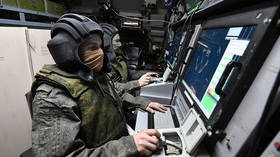U.S. Navy and Lockheed Martin Officially Introduce Directed Energy Weapons Into Warfare
Nearly 4 years ago, I wrote an article entitled, “Lasers and Electronic Warfare To Be Used in New World of Drones and Anti-Drones,” wherein I detailed the trend toward using directed energy weapons in warfare. Unfortunately, it appears that much of the speculation at that time about whether or not this was merely the military-industrial complex looking to fund more boondoggle projects that would never see the light of day actually has become reality.
If swarms of enemy small attack boats armed with guns and explosives approached a Navy ship, alongside missile-armed drones and helicopters closing into strike range, ship commanders would instantly begin weighing defensive options – to include interceptor missiles, electronic warfare, deck-mounted guns or area weapons such as Close-in-Weapons System.
Now, attacks such as these will also be countered with laser weapons being added to the equation, bringing new dimensions to maritime warfare on the open sea.
By 2021, U.S. Navy destroyers will be armed with new ship-fired lasers able to sense and incinerate enemy drones, low-flying aircraft and small boat attacks — all while firing at the speed of light.
The system is called HELIOS (High-Energy Laser and Integrated Optical-Dazzler with Surveillance,) which appears to be a similar system to that of another one that I covered in that previous article from German company, Rheinmetall Defense Electronics, simply called HEL (High-Energy Laser), which they referred to as “HEL on wheels.”
As nation after nation becomes wired for war and neutralizes then surpasses each other, new methods must be developed to maintain military supremacy. This is the nature of military conflict and one of the prime reasons why the world seems to have new security threats each and every day. It becomes one endless problem-reaction-solution loop that only serves to benefit those who are invested in each of the three components.
Now that lasers are being applied to ships, we should be seeing further rollout across the military. Here is a video from all the way back in 2012 which showed where we are probably heading. If this is what is being shown to the public, one can only imagine what is really being planned for the future of warfare.
Nicholas West writes for Activist Post. Support us at Patreon for as little as $1 per month. Follow us on Minds, Steemit, SoMee, BitChute, Facebook and Twitter. Ready for solutions?
Subscribe to Activist Post for truth, peace, and freedom news. Follow us on Minds, Twitter, Steemit, and SoMee.
US Marines are field testing a new laser weapon system designed to blast enemy drones out of the sky, reported The Sun. Silent, invisible and precise -- the new Compact Laser Weapons System (CLaWS) is a directed energy weapon approved by the Pentagon for use by combat personnel.
The Army expects to procure its Multi-Mission High Energy Laser (MMHEL) by 2022 and a hypersonic weapon prototype by 2023, said Lt. Gen L. Neil Thurgood, director of hypersonics, directed energy, space, and rapid acquisition, reported Army News Service.
The Air Force Research Laboratory (AFRL) Self-Protect High Energy Laser Demonstrator (SHiELD) Advanced Technology Demonstration (ATD) Program, has completed a series of tests last month that successfully shot down "several" missiles with a ground-based laser. The field training exercise occurred on April 23 at the White Sands Missile Range in New Mexico, reported the 88th Air Base Wing Public Affairs. The SHiELD program has developed a directed energy weapon that will eventually be molded into an aircraft pod. Fifth-generation fighter jets and drones will soon have the ability to destroy surface-to-air (SAM) and air-to-air (AAM) missiles with laser beams.
Pratt & Whitney, a division of United Technologies corp., announced last Thursday a ‘Growth Option 2.0’ upgrade for the F135 engine, which powers the fifth-generation Lockheed Martin F-35 Lightning II, that could provide increased power and thermal management system (PTMS) capacity.




